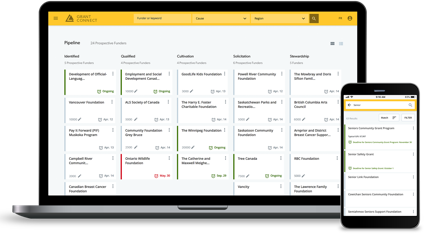360° SPONSORED CONTENT
How often do you talk to your supporters?
If you’re lucky, your nonprofit organization has thousands of them and you might get the chance to have a chat once in a while, maybe at your annual fundraising event, during your AGM, or possibly through a stewardship campaign. But you can’t hope to speak to all of them personally.
So how are you going to get to know your supporters in order to offer them better communication and an improved donor experience? Donor surveys are the answer.
Why Send Donor Surveys?
Donor surveys offer your organization the opportunity to gather information about your supporters and tailor your marketing and communications materials to their preferences.
Why bother? Because people don’t make decisions about where to give based on logic—they give where their hearts tell them to.
By understanding donor preferences and the things they care about, you can begin to better engage with your supporters and build meaningful, mutually beneficial relationships. If you’ve done it right, many supporters will keep coming back to your organization as recurring donors, volunteers, and even as legacy donors.
This is all part of donor retention. From a long-term perspective, retained donors are the most valuable type of supporter you can have, and they’re essential for the sustained growth that will help your organization make a bigger impact on the communities you serve.
What You Need to Know Before You Start
Before you start writing questions, it’s important to understand why you need this data in the first place. It’s one thing to give a donation, it’s another to provide intimate details about background and personal life.
So before you do a deep dive into every facet of your donor base, take a moment to hone in on what you’re trying to accomplish by sending the survey.
Whatever your intent, you should outline the types of data you’d like to have so that you’re not asking for information that doesn't help you achieve your business goals.
The other aspect is ensuring your organization is up to date on privacy.
While surveys are mostly exempt from CASL regulations, if there is messaging that encourages solicitation, then you could be on the hook. Make sure your communications are CASL compliant before you press send!
As your organization collects more and more data, make sure you know:
- How you’re going to store it
- How staff are going to use it
- How you’re communicating your privacy policy with your donors and staff
- Whether you meet not just CASL, but both provincial and federal privacy legislation
Get started with Donor Privacy here:
- Does your organization adhere to the Donor Bill of Rights?
- Personal Information Protection and Electronics Documents Act (PIPEDA)’s Ten Privacy Principles (Section J)
- Create a Privacy Policy using this checklist. Here’s an example.
- Use these 10 tips to make your privacy policy better and more transparent.
What Kind of Data Should You Ask For?
Here are some data categories to guide you toward survey supremacy.
Demographic Data
Demographic data is very simply information about the characteristics of your audience, including:
- gender
- ethnicity
- age
- language
- tenure in Canada
- household income
- homeownership (length of residence, home size, mortgage)
- Communication style/preference
- education
- employment status
- children
- geographical location
- marital status (head of household, spouse)
This type of data is incredibly useful when segmenting your donors into different groups so that you can more efficiently personalize your content.
Motivation
Not sure why donors give to your organization? Ask!
If you know what motivates donors to give and why they care about your mission, it’s much easier to craft communications that connect on an emotional level, which is of course the foundation of any good retention strategy.
Donor Preferences
There is a lot to be said for communicating with people at times that are convenient for them, as well as using their preferred methods of communication. Some people love a phone call, others will stop giving the second they see your number on call display. So go ahead and ask about:
- Communications - email, text messages, phone call, direct mail, time of day, day of the week, etc.
- Donation methods - online, cheque, cash, etc.
Writing Donor Surveys
When it’s time to sit down and actually write your survey, there are some essential things that you need to do in order to give you the best chance at gaining value from the process.
1. Set Goals
Setting goals for your survey will help you keep it concise and deliver the data that you need most urgently. Try to identify gaps in your current data set and write questions that will fill those gaps.
2. Tone of Voice
You want to get the best answers from the broadest array of supporters, so be sure to write in plain, direct language and in a friendly tone. The more text people have to read and the more words they don’t know, the more likely they’ll give up and you’ll lose out on precious data.
3. Question Structure
Write questions that give donors the opportunity to answer in a way that makes sense. Questions can be open-ended, multiple-choice, yes or no, or on a numerical scale. Choose whichever structure is going to give you the most useful data.
4. Questions
There are two quick but important notes about questions that you should consider while writing your survey:
- Be specific - don’t be afraid to write very specific questions that get right to the point. Did you feel that the technology used was set up in a way that was intuitive to users?
- The most important question - Is there anything else you’d like us to know? This is the question that acts as insurance for the rest of your survey. If you forgot to ask something crucial, you can be almost certain that people will tell you given the chance.
How to Send Your Survey
Sending a donor survey is easier than ever thanks to services like Typeform, SurveyMonkey, and Google Forms. These web-based applications let you build your survey and send it all from one location.
Of course, you may have contacts for whom you do not have an email address, so don’t hesitate to send out paper surveys by snail mail.
If you have a large social media following, a Facebook Survey may also be a good option, though respondents may be less forthcoming with information due to privacy issues surrounding Facebook.
What to Do With Your Data
Okay, you’ve set goals, written questions, sent your surveys, and lots of donors responded—what can you do with all that data?
Create Personas
Donor personas let you define the archetype of your ideal donor, allowing you to seek out supporters with similar profiles during your next acquisition campaign.
Understand Journeys
Donor journeys help you understand where your donors are in their giving cycles so that you can send the right messaging at just the right time.
Personalize Communications
Above all else, more knowledge about your donors lets you communicate with them in ways that they prefer and that cater to their needs and interests, eliciting better engagement and interaction, and ultimately leading to more revenue for your organization.
Now get out there and ask every little burning question your heart desires!
Guest contributions represent the personal opinions and insights of the authors and may not reflect the views or opinions of Imagine Canada.
A storyteller by nature and an organizer by inheritance, Sam enjoys crafting meaningful content equally as much as colour coding spreadsheets. As the Marketing Director at Keela, a Canadian Donor Management Software (CRM), she is always on the hunt for new and innovative ways to educate nonprofits and help them maximize their impact.





